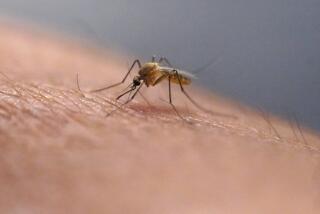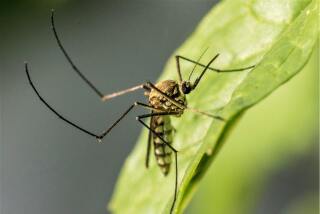West Nile Virus Cited in 2 Deaths
- Share via
Two San Bernardino County men died of complications from West Nile virus, including a World War II veteran who survived the Bataan Death March, health officials announced Tuesday.
Julius Krick, 81, a former prisoner of war and career military man from San Bernardino, died Aug. 13, and Merle Mills, 88, a religious leader who lived in Africa for more than a decade, died Monday, San Bernardino County coroner spokesman Rocky Shaw said.
The virus has killed nine people in California in the last two months. Four of the deaths, including those of Mills and Krick, occurred in San Bernardino County.
Local health officials said they expect more fatalities because the virus spreads rapidly in warm weather.
“We’re in the middle of the season. We have probably two more months of warm weather,” said Jim Felten, public health officer with the county Department of Public Health.
“We would expect to see more cases. It’s impossible to predict the number of deaths.”
West Nile virus, which is spread by mosquitoes that bite infected birds, was first seen on the East Coast in 1999 and began moving west. Last year, California had three locally contracted cases, the first of which was a Moreno Valley man who worked near the Santa Ana River.
Most people infected by West Nile virus have no symptoms. Twenty percent develop mild symptoms, such as fever and rash, but 1% can develop more severe symptoms that can lead to coma, convulsions or death.
Statewide, 277 infections have been reported, according to figures released Tuesday by the California Department of Health Services.
Felten said more local cases could be expected for several more weeks, until temperatures decrease. There will be a winter lull, then one more summer with a large number of infections.
“After two years, it falls off tremendously,” he said.
Felten urged residents, especially the elderly, to take precautions such as avoiding the outdoors at dawn and dusk, wearing long sleeves and using an insect spray that contains DEET.
County officials will continue limited ground-fogging with pesticides to kill mosquitoes, next targeting San Bernardino and Loma Linda.
Krick became sick in early August, said his son, John Krick. Although he died Aug. 13, West Nile was not diagnosed until Monday.
It was not Krick’s first experience with a mosquito-borne virus. His son said Krick had malaria -- and a host of other illnesses that caused his weight to drop to 95 pounds -- during his tour of duty in the Pacific during World War II. He was a prisoner of war for three years and survived the Bataan Death March, his son said.
Krick, a recent widower with two grown children, had served in the military for 22 years and was a retired public servant.
He spent much of his time in recent years volunteering for Easter Seals and speaking to high school students about his experience as a POW.
“He was just a great guy,” John Krick said.
Krick first saw a doctor Aug. 6 after having a fever for a couple of days, but the doctor was unable to diagnose the cause.
Krick took a quick turn for the worse in the following days and on Aug. 9 doctors discovered he had suffered a heart attack, probably because of the stress of the illness, his son said.
Krick died at the Loma Linda Veterans Affairs Medical Center, where a hospital test found West Nile exposure.
County health officials are conducting a second test to confirm the findings.
Mills, a former leader in the Seventh-day Adventist Church in Loma Linda, was taken to the hospital July 24 after collapsing. His family suspected heat exhaustion, but a spinal tap showed signs of meningitis, said his son, Myron Mills.
Mills died at Loma Linda University Medical Center. Two tests by the county health department confirmed a West Nile infection. He is survived by Elizabeth, his wife of 65 years, son Myron of Tennessee, daughter Marjene Castro of Maryland, and eight grandchildren and great grandchildren.
Mills lived in Zimbabwe from 1966 to 1980 and traveled throughout southern and central Africa for the church.
“That was the irony: He lived in Africa for 14 years and never had one bout of malaria,” his son said. “But he came back to Southern California and died from the bite of a mosquito.”
More to Read
Sign up for Essential California
The most important California stories and recommendations in your inbox every morning.
You may occasionally receive promotional content from the Los Angeles Times.






![Vista, California-Apri 2, 2025-Hours after undergoing dental surgery a 9-year-old girl was found unresponsive in her home, officials are investigating what caused her death. On March 18, Silvanna Moreno was placed under anesthesia for a dental surgery at Dreamtime Dentistry, a dental facility that "strive[s] to be the premier office for sedation dentistry in Vitsa, CA. (Google Maps)](https://ca-times.brightspotcdn.com/dims4/default/07a58b2/2147483647/strip/true/crop/2016x1344+29+0/resize/840x560!/quality/75/?url=https%3A%2F%2Fcalifornia-times-brightspot.s3.amazonaws.com%2F78%2Ffd%2F9bbf9b62489fa209f9c67df2e472%2Fla-me-dreamtime-dentist-01.jpg)







